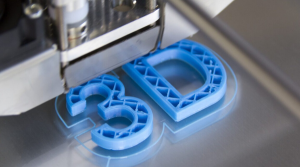Phoenix 3D Printing speeds up design iterations and enables small production runs. Compared to traditional prototyping and manufacturing methods, it also minimizes lead times.
Unlike CNC machining or injection molding, molds are not needed for each new product. That means the time and cost to switch from one design to another are minimal.

The evolution of 3D printing has been nothing short of a manufacturing revolution. Once considered a futuristic technology, it has become an indispensable part of design and engineering across various industries. 3D printing can create parts and components that are impossible to produce through traditional manufacturing methods, allowing engineers to build complex shapes that would not be possible otherwise. These parts and components can also be lighter and more durable than those produced through traditional methods, reducing costs and increasing performance.
3D printing, also called additive manufacturing, is the process of constructing three-dimensional objects from a digital model. This can be done using a number of techniques in which material is added to the object through deposition, joining or solidification under computer control, usually layer by layer. The earliest roots of 3D printing go back to 1860, when French artist Francois Willeme patented a photo-sculpturing method whereby the subject was placed in a circular room and photographed simultaneously by 24 cameras evenly spaced around it. The resulting photographs could then be traced onto wood to create a photo-sculpture.
During the 1980s, inventor S. Scott Crump developed the most popular 3D printer technology to date—Fused Deposition Modeling (FDM). This 3D printing method used layers of melted and bonded plastic materials, which made it cheaper and easier to use than its predecessors, stereolithography and selective laser sintering (SLS). Crump formed a company that named itself Stratasys and continues to be a leader in the field today.
In 1989, a German additive manufacturing company developed Direct Metal Laser Sintering, or DMLS. This was the first method to produce entirely metal parts through 3D printing, opening up a whole new range of applications for the technology. This allowed manufacturers to consolidate components into fewer parts, which reduced weight and cost and improved strength, while removing weak points and improving efficiency.
During this time, the open-source paradigm that would dominate the information technology industry began to impact the manufacturing world as well. In 2005, Adrian Bowyer launched the RepRap project in England, which aimed to develop a 3D printer that could manufacture most of its own parts. This project, which eventually led to the 1.0 Darwin machine, gave home 3D printing another big boost, and the industry grew rapidly from there.
Benefits
Many businesses use 3D printing to make a variety of prototypes and models. These are used for market testing and validation, which is a critical step in product development before a new design can be launched. Having access to a 3D printer enables companies to shorten this process, speeding up their time to market. For example, PepsiCo developed multiple prototypes of its Ruffles potato chips before choosing the winning flavour and launching it into the market.
Another benefit is the ability to make spare parts and tools quickly. This is one of the fastest and cheapest business uses of 3D printing, helping reduce downtime caused by the need to replace worn or broken equipment. It also reduces the costs of inventory storage and enables a more JIT and on-demand production approach, which can help drive down supply chain costs.
In addition to saving on inventory and cutting sunk cost expenses, 3D printing can also improve the flexibility of a company’s operations. By internalising production, a company can avoid the high minimum order quantities (MOQs) required by contract manufacturers, as well as having more control over pricing and lead times.
The precision and exactness of the printing process also makes it much easier to redesign a product if there is a flaw in the design, as a CAD file can be modified to correct the error and then printed out straight away. This is a big advantage over traditional manufacturing processes, which require significant upfront capital investments and can be costly to change if there is a problem.
Finally, a major benefit of using 3D printing is that it produces less waste than other manufacturing methods. In subtractive manufacturing, pieces of material are cut away from a block of metal until the final part emerges, which results in a lot of scrap that needs to be discarded and cleaned up. However, a 3D printer works from a CAD file and only releases the materials that are needed to create the final part. This eliminates the need for scrap and reduces the waste produced by other manufacturing processes.
Materials
There are many different types of printing materials that can be used with 3D printers. These include plastics, metals and resins. Some specialty printers can also work with concrete and biological material.
The most common type of printing material is plastic, which comes in a variety of different colors and textures. Depending on the type of plastic, it may be rigid or flexible. Some plastics are designed to be chemical resistant, while others have a high heat resistance. The most popular plastics are polylactic acid (PLA) and ABS. PLA is made from plant-based substances and is biodegradable, while ABS is an engineering plastic that can be used to create durable parts.
Nylon is another common 3D printing material. It is often reinforced with carbon or glass fibers to increase its strength. These composites are lighter than traditional plastics, making them ideal for parts that need to be lightweight but have high mechanical qualities.
Other popular 3D printing materials are thermoplastic elastomers, such as TPU and PEKK. These materials are flexible and can be shaped to fit the needs of the part. They are also resistant to chemicals and abrasions. Thermoplastic urethanes are particularly useful in medical applications because they can be printed in transparent and translucent colors, which allows doctors to better see the inside of a patient’s body.
Polycarbonate is another sturdy filament that is ideal for parts that require significant impact resistance and ductility. It is often used in safety equipment and tool housings, as well as eyeglasses. It can be strengthened further with carbon or glass fibers to produce stronger, lighter components.
Another popular 3D printing material is ASA, which is an amorphous thermoplastic terpolymer similar to ABS. It is also easy to post-process and can be sanded, polished, painted and bonded. ASA can also be milled, drilled and glued; however, it should not be exposed to heat above 200°C.
Soluble materials are 3D printing materials that can be dissolved at a later stage of the manufacturing process. These materials are usually made from natural products such as sugar cane and corn starch. They are available in both soft and hard varieties, with the latter being more durable.
Processes
The process of three-dimensional printing is additive, meaning that it builds a physical object by layering and fusing layers of material. The steps involved in the fabrication of a 3D model differ depending on the type of material used, but all 3D printers build parts from thin layers of liquid or powdered plastic, metal or cement that are then fused together.
The first modern 3D printing innovation was stereolithography (SLA), which uses a light source to cure and solidify a liquid photopolymer resin layer by layer until the desired part is formed. This type of 3D printing delivers high levels of detail and accurate geometry, as well as smooth surface completions and tight resistances.
Another popular form of plastic 3D printing is fused deposition modeling (FDM), which works by melting and depositing a thin stream of heated polymer onto a flat bed. A computer program then translates the digital file into a series of commands that tells the machine what thickness to deposit each layer. The melted plastic adheres to the previous layer and the result is a structure that can take on many forms, from simple parts like nozzles or handles to complex assemblies such as housings or electrical connectors.
Laser sintering (SLS) and direct metal laser fusion (DMLS) are two other metal 3D printing methods that use an energy source—a laser, electron beam or plasma arc—to melt and fuse metal powder or wire on a printed work surface. This creates an object that is heat-resistant, strong and durable—and more accurate than cast metal parts.
Once the print job is complete, the final product is washed in isopropyl alcohol to remove any excess resin. In some cases, it is also post-fixed in a bright oven to strengthen the printed item.
Other processes are emerging to use a variety of materials, including ceramics and metals. As these technologies become more affordable and widespread, they can help transform 3D printing from a prototyping technology into a production process.
